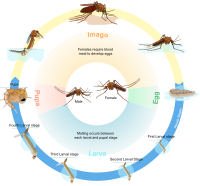
Photo from wikipedia
Background Gaining further insights into SARS-CoV-2 routes of infection and the underlying pathobiology of COVID-19 will support the design of rational treatments targeting the life cycle of the virus and/or… Click to show full abstract
Background Gaining further insights into SARS-CoV-2 routes of infection and the underlying pathobiology of COVID-19 will support the design of rational treatments targeting the life cycle of the virus and/or the adverse effects (e.g., multi-organ collapse) that are triggered by COVID-19-mediated adult respiratory distress syndrome (ARDS) and/or other pathologies. Main body COVID-19 is a two-phase disease being marked by ( phase 1 ) increased virus transmission and infection rates due to the wide expression of the main infection-related ACE2 , TMPRSS2 and CTSB/L human genes in tissues of the respiratory and gastrointestinal tract, as well as by ( phase 2 ) host- and probably sex- and/or age-specific uncontrolled inflammatory immune responses which drive hyper-cytokinemia, aggressive inflammation and (due to broad organotropism of SARS-CoV-2) collateral tissue damage and systemic failure likely because of imbalanced ACE/ANGII/AT1R and ACE2/ANG(1–7)/MASR axes signaling. Conclusion Here we discuss SARS-CoV-2 life cycle and a number of approaches aiming to suppress viral infection rates or propagation; increase virus antigen presentation in order to activate a robust and durable adaptive immune response from the host, and/or mitigate the ARDS-related “cytokine storm” and collateral tissue damage that triggers the severe life-threatening complications of COVID-19.
Journal Title: Journal of Biomedical Science
Year Published: 2021
Link to full text (if available)
Share on Social Media: Sign Up to like & get
recommendations!